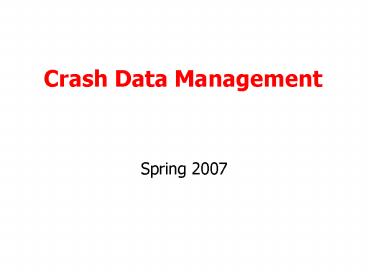Crash Data Management - PowerPoint PPT Presentation
1 / 28
Title:
Crash Data Management
Description:
NHTSA: CODES Project. Other Data. Other data files: Photolog and videolog ... General Estimates System: http://www-nrd.nhtsa.dot.gov/departments/nrd-30/ncsa/GES.html ... – PowerPoint PPT presentation
Number of Views:37
Avg rating:3.0/5.0
Title: Crash Data Management
1
Crash Data Management
- Spring 2007
2
Crash Data
- Crash data remains the number one indicator of
network deficiencies (others traffic conflicts,
driving task analysis) - Crash data used for
- Identification of hazardous sites
- Benefit-costs analysis
- Safety relationships (statistical models)
- Highway design process
- Policy development
3
Data Users
- Traffic Engineers elimination of hazardous
sites highway design, etc. - Police force enforcement location, etc.
- Researchers understanding the crash process
safety relationships, etc. - Decision-makers alcohol measures, speed limit
- Prosecutors transportation-related criminal
lawsuits, eye witness statements, etc. - Insurance companies set premiums, types of
vehicles, age of drivers, - Vehicle manufacturers research for safer vehicles
4
Crash Report
- Quality of data highly dependent on the officer
at the scene of the crash - Most important data are collected for potential
criminal prosecution other data less important - Sometimes officers fill out the report on the
scene while others do it at the end of the day
(see next overheads) - Important to have an open line of communication
between the engineering and police departments
5
Computerized Crash Report
- Portable computers improve legibility and could
reduce errors increase workload at the scene of
the crash - Pen-based computers officer writes on a notepad
and software transform characters written on the
pad - Palmtop computers pen-based screen takes little
space on the computer - Bar codes read information off the drivers
license, vehicle, vehicle registration, etc. - Modems upload information directly to the police
station - Some issues prosecution may need handwritten
statement some officers may not have the skills
necessary for handling computers (less an issue
now, but was probably 10 or 15 years ago)
6
Critical Information
- Geographical location (intersections, mile-point,
GIS) - Date (year, day of week, time of day, etc.)
- Type of involvement (vehicle, driver, occupants,
etc.) - Outcome (severity)
- Environmental conditions (weather, lighting, road
surface conditions) - Characteristics of collision (direction of road
users, errors, collision type)
7
Critical Information
8
Critical Information
9
Location Methods
- Location of the crash is the most important
aspect of data collection - Estimate hazardous sites that experience more
crashes than what would be expected - Provide a usually way to link different databases
- Three methods Link-Node, Route-Km Post (aka
Control-Section), GPS coordinate
10
Road System Inventory
11
Link-Node
Nodes
Link
12
Route-Km Post
Every 200 m, there is small post on the side of
the road
Highway 1
Distance 0
Highway 2
13
GPS System
- Provides X and Y coordinates of a given
geographical coordinate system - Two methods with and without differential
processing against a base station (the first is
more accurate) - Advantages human error free many software tools
include GPS coordinate can estimate in the
Z-coordinate (depth) - Disadvantages sky-view problems (buildings,
mountains, etc.) algorithm needed to convert GPS
to other referencing systems depending on
equipment, human errors could contribute to
accuracy problems
14
Road System Inventory
15
Crash Data Storage
- Old way paper trails
- All crashes are coded electronically (e.g.,
upcoming CRISS in Texas) - Now, commercial programs available that displays
visually simple crash statistics - Internet-based visual tools (using GIS/GPS
capabilities ARCView, etc.)
16
Crash Data Limitations
- Not all crashes are reportable
- Personal injury (definition)
- PDO (limit, changes over time)
- Not all crashes are reported
- Next overhead
- Reported crashes may contain errors
- On report, fraudulent claims
17
Crash Data Limitations
- Not all crashes are reported
- Ignorance of the law
- Victims unawareness of injury at the time of the
collision - Desire to avoid bureaucracy
- Desire to avoid insurance company penalties
- Type of collision (single vehicle versus
multivehicle) - Type of users (bicyclists and pedestrians)
- Police force (report level varies by jurisdiction)
18
Crash Data Limitations
19
Crash Data Limitations
20
Other Data
Road Inventory
21
Other Data
Road Inventory
22
Other Data
Traffic Data
23
Other Data
Hospital
NHTSA CODES Project
24
Other Data
- Other data files
- Photolog and videolog
- Maintenance and operation files
- Project history (construction period)
- Insurance companies (usually private)
- Weather reports
25
Integrated Data System
- Considerations
- Control and maintenance of the system
- Responsibilities and tasks for data collection
- Data should be managed by the organization that
most needs the data - Confidentiality of data obtained (drivers name,
etc.) - Level of accuracy of data (aggregated versus
disaggregated data)
26
Integrated Data Files
27
Integrated Data Files
Linking Files
See NCHRP 17-29 project
28
Sources of Data
Highway Safety Information System
http//www.hsisinfo.org/ Fatality Analysis
Reporting System http//www-fars.nhtsa.dot.gov/ N
ational Automotive Sampling System
http//www-nrd.nhtsa.dot.gov/departments/nrd-30/nc
sa/NASS.html General Estimates System
http//www-nrd.nhtsa.dot.gov/departments/nrd-30/nc
sa/GES.html Crashworthiness Data System
http//www-nrd.nhtsa.dot.gov/departments/nrd-30/nc
sa/CDS.html Model Minimum Uniform Crash Criteria
http//www-nrd.nhtsa.dot.gov/departments/nrd-30/nc
sa/MMUCC.html Bureau of Transportation
Statistics http//www.bts.gov/programs/safety_dat
a_initiative/ Each State Agency should have data
available. Local cities or counties may have data
available.































